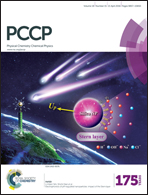Surface hopping investigation of benzophenone excited state dynamics†
Abstract
We present a simulation of the photodynamics of benzophenone for the first 20 ps after n → π* excitation, performed by trajectory surface hopping calculations with on-the-fly semiempirical determination of potential energy surfaces and electronic wavefunctions. Both the dynamic and spin–orbit couplings are taken into account, and time-resolved fluorescence emission is also simulated. The computed decay time of the S1 state is in agreement with experimental observations. The direct S1 → T1 intersystem crossing (ISC) accounts for about 2/3 of the S1 decay rate. The remaining 1/3 goes through T2 or higher triplets. The nonadiabatic transitions within the triplet manifold are much faster than ISC and keep the population of T1 at about 3/4 of the total triplet population, and that of the other states (mainly T2) at 1/4. Two internal coordinates are vibrationally active immediately after n → π* excitation: one is the C![[double bond, length as m-dash]](https://www.rsc.org/images/entities/char_e001.gif) O stretching and the other one is a combination of the conrotatory torsion of phenyl rings and of bending involving the carbonyl C atom. The period of the torsion-bending mode coincides with oscillations in the time-resolved photoelectron spectra of Spighi et al. and substantially confirms their assignment.
O stretching and the other one is a combination of the conrotatory torsion of phenyl rings and of bending involving the carbonyl C atom. The period of the torsion-bending mode coincides with oscillations in the time-resolved photoelectron spectra of Spighi et al. and substantially confirms their assignment.


 Please wait while we load your content...
Please wait while we load your content...